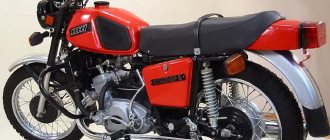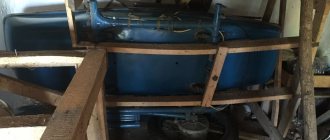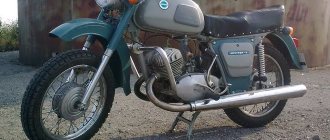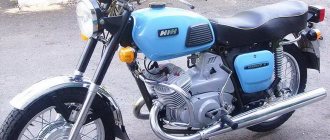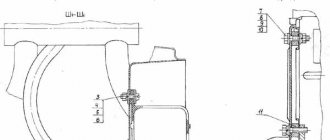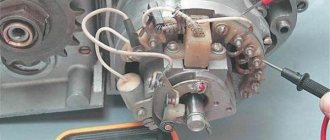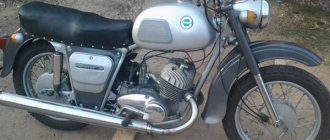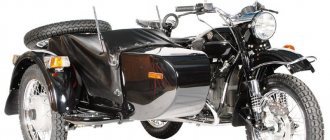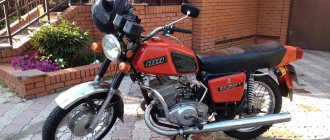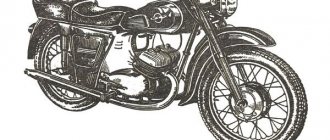In 1980, the Izhevsk Machine-Building Plant launched the IZH Jupiter 4 road motorcycle for mass production. The fourth generation replaced its predecessor IZH Jupiter 3 on the production line and was produced until 1986.
Jupiter 4 could confidently move on roads with any surface, and its key feature was the ability to be used together with a passenger side trailer, which made it possible to transport two passengers at once or use the trailer to transport small loads.
It is the increased passenger capacity that has become an important component of the popularity of motorcycles. In addition, it had the following advantages:
- good dynamic characteristics;
- ease of repair;
- high cross-country ability;
- affordable price;
- high reliability;
- low sensitivity to fuel quality.
The existing disadvantages of IZH Jupiter 4, according to reviews from owners, include:
- poor assembly quality at the factory (connections not tightened, poor contacts, oil leaks);
- violation of synchronization in the operation of the engine cylinders;
- poor wiring diagram;
- frequent overheating of the engine when fully loaded in warm weather.
But due to the corresponding advantages, the motorcycle was most popular among rural residents as a universal vehicle.
Basic data of IZH Jupiter 4K in millimeters - mm.
Wheelbase (distance between wheel axles), - 1450 Ground clearance at full load and normal tire pressure, - 125 Overall dimensions: length - 2200 width - 1700 height - 1800 Weight (dry), kg. — 255 Maximum load, kg. — 265 Load on side trailer, kg. — 115 Maximum speed, km/h. — 95 Braking distance at a speed of 60 km/h, in meters. — 25 Control fuel consumption per 100 km in liters — 7.5
Back to contents — ↑
I finally sat down to write the main post, which is why I registered on this site. We will talk about fine-tuning, boosting and improving the characteristics of the IZ Jupiter5 engine.
I rode on stock for a couple of years and then came this feeling that probably visited every motorcyclist: “I’m not enough...” 350cc but 24hp is negligible, and I didn’t want to sell the first motorcycle that changed my whole life. Here it was decided to increase the power of the 25-year-old old man. I want to warn you right away that the post was not created for bragging, they say that my Jup is all like this, he is ruining everything... First of all, I will highlight the problems that arise when forcing, I will show how I solved them, what was difficult for me and who helped me with what. I'm not a 2T ICE guru, I'm just learning, so there will be a lot of criticism. Oh yes, most importantly, those who will write why throw so much money and time into IZH, it will remain IZH. Of course, he will remain an IZh, only one that pleases passers-by and makes them turn around when he breaks away from a traffic light. For some reason, most people are inclined to ride everything ready-made and the only modifications that come to mind are the Puig windshield and the Akrapovic pipe. I don't judge such people, but don't judge me either. If I do something, it means I live, not exist, and the completion of this project can last a long time, the main thing is pleasure! This is what it looked like before finishing. Everything was stock, only consumables were changed.
It all started with a suggestion from a friend. I was offered adapters for Sova LC, houses, a “PROTOLAB” intake resonator and 2 Jikov carburetors. Of course, I couldn’t resist and bought it.
I didn’t want to experiment with the stock engine, because I wanted to be able to return everything back, and with a boost it’s almost impossible. It was decided to get a used IZH Jupiter5 motor from old stocks.
About the motor. The crankcase is in good condition, the IZH Jupiter3 shafts with NGSh 29 on bushings without a shaft, the Yu3 USSR gearbox is new, the CPG with Almot pistons after running in (it’s even very good that I didn’t install a new piston because when setting up 2 carbs it’s easy to screw up the pots with a lean mixture ), narrow basket, Atlant disks, YAP bearings, Erics seals. In a word, the most expensive parts of the engine were the consumables, the rest for testing were ordinary spare parts. Here's what someone might need: Atlant discs are of excellent quality, the clutch on these discs is soft, easy to adjust, the discs do not fall out or break off.
Erics seals:
SKF bearings:
The cylinders remained stock, the purge was not touched, they were just painted with black heat-resistant paint (I immediately show an excerpt from Grigoriev’s book regarding the fact that black cylinders will overheat).
Very important! When installing reed valves, you need to increase the intake phase, but I made it constant as in the photo. (the photo is not mine, I’ll find my pistons and remove them, but the holes are identical) By the way, you can already see everything in the engine through the intake windows.
The heads were set back slightly to raise the compression ratio.
Now the motor is assembled and is expected to be installed on the frame.
Here is the engine on the frame, this is where the fun begins.
The main difficulty in installing 2 carburetors, as for me, is adjustment. And not just that it would drive, but that it would work smoothly, without failures and with brown soot on the spark plugs - This is what I call a tuned power system! Fortunately, Pavel Prikhodko, the creator of Protolab, wrote a detailed article on adjusting carburetors, for which many thanks to him. Here it is: Adjusting the carburetors I installed the carburetors from Jicov, drilled the jets myself using a very useful table that I think someone will need. Regarding filters, I used Minsk paper filters and Ural motorcycle pipes. I recommend NGK BP6HS spark plugs; their heat rating is equal to that recommended by the manufacturer of the IZH engine, and besides, spark plugs are the first indicator and indicator of the quality of the mixture. If the candle is gray or white the mixture is poor, if it is black it is rich, if it is brown everything is fine!
The setup was painfully long, so if anyone encounters this, be patient ;)
After a while, I was able to adjust the carburetors, without failures with the correct operation of the engine.
By the way, I immediately ordered resonators for my engine at 5500 rpm from Anatoly Tkachenko.
After adjusting the carburetors, the motorcycle ran like new. The dynamics have improved, I was already happy BUT. 1 Problem: I drove a KSZ (contact ignition system) for 3 years, I had no problems, since I always looked after the engine and the bearings are always in excellent condition. But after installing 2 carbs and resonators, I began to turn the engine over 5000 and the gearboxes at these speeds began to work incorrectly, namely, a spark was missed, despite their excellent condition. This was all to be expected, so after a couple of days I already installed the BSZ with FUOZ (AZ and cut-off 4000 rpm) + bought an electronic tachometer. For information about the place of purchase, write in PM.
I drove away for about a week to celebrate. I revved the engine above 5000 on the light side. And then a new problem appeared. 2 Problem: Since my valve is made in China, there were some unpleasant moments. On Soviet ones, the plastic is stronger and the valves do not leak.
And even though I made holes for unloading the petals as in the photo below (photo not mine), it didn’t really help.
Over time, the petals began to fit poorly and as a result the motor did not work correctly. There are 3 ways to solve the problem: 1. Look for the USSR LK, but in Ukraine this is almost impossible. 2. There is a huge choice of installing LC on foreign cars, Honda NSR, Yamaha RD and so on. BUT here the price of the valves is steep and the adapters need to be completely remade. 3.Make the LC according to the size of the owl, but not from plastic, but from another more durable material. Personally, I decided to try casting a housing for the LC from aluminum. A good person helped me with this, how to find him, write in PM This is what they look like.
The LC without limiters has been driven on my engine for a year now and nothing has broken off, the petals always fit snugly, the body does not lead.
Again, everything is assembled, adjusted, and the rides begin again.
The bike started running completely differently and I liked it, but I didn't like the Jicov carburetors for some reasons. They are not convenient to use, very capricious when adjusting, the fastening on the manifolds is weak. In general, I decided to try out the k68D Pekar.
Immediately the result lived up to expectations in that it responded to tuning more easily than Java carburetors. Since I tried the GTZ 260 to begin with, it overflowed and it didn’t really drive. I screwed in a GTZ 190 from a Ural motorcycle. The engine obviously didn’t have enough of the poor mixture. I thought about screwing in 200 from the Sova motorcycle, but it’s hard to find them since the Soviet ones are no longer available anywhere, and in new-made repair kits on the jets only the numbers are filled in correctly, but in real life the hole does not match the designation for flow capacity. For example, I bought a 200 gtzh for an owl, and when they were spilled, it turned out to be 270. I decided to drill 190 with a 1.1 drill so that it would be approximately 225 gtzh. In the end, everything worked out and it didn’t turn out bad! The spark plugs are barely brown and the engine starts to run confidently!
The engine worked well, but it took better power from the bottom and I decided to somehow do this on my K68D. How to improve the bottom on the K68D First of all, I decided to carefully sharpen the needles, this procedure requires nerves and precision, since every time I try to put it back, it takes a lot of time to disassemble. INFO about Carburetors I rummaged around on the Internet and saw such a device as the Power Wing PHOTO I read articles, searched in books about it, everything I found was these details.
What changes have occurred: 1. After installing PW, the carburetor settings were completely lost. 2. After adjusting the carburetors, I noticed that I began to keep the speed lower, it was more stable at low speeds, and it started faster from a standstill. They also installed the same ones on the stock Jupiter + no -. Therefore, I advise, after all, it’s not for nothing that the Powerwing price is $120.
Over time, the spark plugs began to turn white and I decided to make jets of greater capacity. But I couldn’t find such a drill and a very good man, an excellent master of 2t internal combustion engines, Anatoly Lukyanenko, helped me. Anatoly made me custom 2 jets 240. Which are still on my carburetors. I’m adjusting the carburetors on my own and at the same time helping my nephew with his Honda)
I’ll also tell you about such an improvement as the collapsing star from the Planet to Jupiter.
Many people have done it and tried, but I’ll just tell you how it really is and my impressions. I’ll take most of the photos from my friend Drobot Vovchik, he did the same thing and still has photos. So I got to the point that 4 speeds are not enough for me even with a 21 tooth sprocket. A 5-speed gearbox on the IZH is not an option, but I somehow wanted to increase the gear ratio. Therefore, I decided to do this using the colval star IZH PLANET. On Jupiter this star has 21 teeth, on the planet it has 24. In this way I decided to increase the speed. Unfortunately, the stars are not identical, so there are some changes: 1.
The star is set back by 4mm without changing the taper! The work is done by a turner! The end of the seat must be cut off by 4mm, otherwise it will rest against the bearing and will not sit properly on the shaft! 2. A huge problem is the size of the chain! The native one is not enough, but you need to add 1.5 links. Not 2 links is a lot, and not 1 is not enough! There is no point in picking up a chain from a Muscovite either! Here in the photo you can clearly see how my friend’s method can cope with the problem.
As a result, the chain does not sag and the basket rotates freely.
Now let's move on to reality. I rode this chainring for 1 day because I was afraid for the chain design. The speeds really became longer; in the terrain I turned on speed 3 from time to time, but never reached 4 at all. On highway 4 it became smoother and longer. In general, it was a matter of taste. For those who often travel long distances and not through the mountains but on a flat road, this option is excellent. But I’m used to an aggressive driving style, I rev the engine to the limit and therefore, as it turns out, I don’t particularly need such a star.
In fact, in this configuration, I drove the whole season until winter until the CPG was completely worn out and the spruce compression meter was dialing the number 6.
I also drove 100 km. From home everything was fine, the motorcycle did not let me down, but only made me happy every time I opened the gas.
And finally, the most important thing, the conclusions and results that I came to. 1. Dynamics have improved on all ranges. 2. Traction from the bottom significantly improved the acceleration and start, and the motorcycle rode confidently up any hill, even with a passenger and a star at 21. 3. Acceleration improved due to 2 carburetors, I didn’t measure how much but the Tazy 1.6 V 16 from the start to a speed of 100 km. at one o'clock I break. 4. In the operating range of the resonators, a second wind characteristic of 2t appeared. Well, the sound, of course, makes people turn around in my wake) 5. Because of the BSZ, the motor runs softer and is easier to tune. In general, it takes a long time to describe everything, it’s easier to just try it and everything will become clear. In a word, I am satisfied with my work and I think it was not in vain that I spent a lot of time in the garage.
This + is now about -. 1. With this engine, the stock brakes seem very weak. (It’s not for nothing that great boosters say that tuning and boosting should start with the brakes)! 2. The stock suspension of the IZh is already not very good, but with this engine it’s generally the same. 3. The motor has become more powerful, and therefore less durable, so I want to strengthen some components in the motor. 4. Due to the flywheel up to 3kg. It seems like the revs are getting low. I think I can solve all these disadvantages over the winter and assemble a new motor.
Answers to frequently asked questions. 1. How much does he eat? -Of course, half of the schoolchildren have IZH 170 and Java 180, but I will still answer. According to the speedometer, everything is 160, but the GPS shows 135-140, next season I will try to prove this by attaching a video. 2.How much to 100? -I haven’t measured it, but it’s faster than the same Priora! 3. How much money did you invest? - I don’t tell anyone. 4.Is it difficult to adjust carburetors? -YES 5. How much does it eat (this is probably the most constant question) - Consumption is 6-7.5 liters per 100, everything depends sooo much on driving style! 6.Java is vomiting now? — Java and stock IL can outperform since I don’t see any significant differences in the engine, power and other indicators between these 2 motorcycles. That's all. This motor has already been disassembled and a completely new motor has been assembled with the jambs and disadvantages that were removed before. More on this in the next post.
Engine IZH Jupiter 4K technical specifications
Engine type - Two-stroke, two-cylinder Cylinder diameter, mm - 62 Piston stroke, mm - 57.6 Compression ratio - 9.95 Displacement, cm³ - 347.6 Maximum engine power (at 5600-6200 rpm), l. With. — 28 Lubrication system — together with fuel Ignition system — battery Carburetor — K-62D Fuel used — gasoline with an octane number of at least 76 Air cleaner — contact oil Cooling — counter-flow air
Back to contents — ↑
About the disadvantages
It is worth noting that among owners of IZH motorcycles, the Jupiter IZH-4 model is not very popular. Experienced users claim that the fourth “Jupiter” is the most unsuccessful model from the entire range of IZH motorcycles. In addition to the fact that the strength of the high-speed engine leaves much to be desired, Jupiter-4 has the following “diseases” and disadvantages:
- constant oil leakage from the engine crankcase;
- “ringing” of fingers after short use;
- short gearbox resource;
- constant problems with the ignition system;
- high fuel consumption;
- lack of monitoring systems for fuel level, engine temperature and oil level in the crankcase;
- out-of-date design;
- Lack of knowledge in the field of operation and repair of this motorcycle can lead to significant material costs for repairing the unit and/or treating the biker.
Most owners of Soviet motorcycles are confident in the above. Particular attention must be paid to the ignition system. In fact, the process of setting the ignition timing does not require phenomenal skills or special knowledge.
Power transmission IZH Jupiter 4K technical specifications
The transmission from the engine to the clutch is a double-row motor chain. The clutch is multi-plate in an oil bath. The gearbox is four-speed. Gear shifting is by foot lever, with automatic manual clutch release. Transmission to the rear wheel is a single-row chain, protected from dirt, sand and moisture. Gear ratio from the engine to the clutch - 2.57 Gear ratio to the rear wheel - 2.63 Gearbox ratio: At first speed - 3.17 At second speed - 1.81 At third speed - 1.26 At fourth speed – 1.0 Overall gear ratio: In first gear – 21.35 In second – 12.24 In third – 8.48 In fourth – 6.74
Back to contents — ↑
How did the motorcycle from the USSR IZH Planet 5 differ from IZH Planet 4
Back in 1962, the first motorcycle called IZH Planet appeared on the assembly line of the Izhevsk Motorcycle Plant. This was the first model of the legendary Planet series, which ended in 2008 with the IZH Planet 5 model. Quite a long history of 46 years, which gave the USSR a number of excellent motorcycles. And if the first motorcycle, for obvious reasons, was very different from the latest model, then the difference between the 4th and 5th models may be minimal, we’ll look at that today.
Let's draw a line between the IZH Planet 4 and IZH Planet 5 models. Well, apart from the year of manufacture, for Planet 4 it is 1983, and for 5 1987 they are distinguished, of course, by their appearance. With the same single-cylinder engine, they have different numbers of exhaust pipes, the Planet 4 has two, and the Planet 5 has one pipe installed. The engine power itself was also different, the 4 had a 20 horsepower engine, the 5 had a 22 hp unit. On the fifth model, the dashboard has been changed, in which the ignition switch is made separately, and on the 4th it is located next to the motorcycle indicator lamps.
Electrical equipment IZH Jupiter 4K technical specifications
Battery – 12 volts, 6MTS-9. Alternating current generator – 12 – volt 100W, 28.3701. Turn signal relay – electronic IZHRP2S M-10. Ignition coil – IZhPS sb. 39. Rectifier regulator – BPV-14-10. Headlight with optical element – FG-137. Rear light – FP-246. Turn signal lights -16.3726. Sound signal – S-205V. Ignition switch – 14.3704 Switch for direction indicators and headlights – IZhP-104. Light switch and emergency ignition switch – IZhP-101. Handbrake brake light switch – RZhVK-103 Foot brake brake light switch – IZH sb. 38-0. Spark plug - A-23. Speedometer – SP-158 or SP-102.
Back to contents — ↑
Differences from its predecessor
The equipment in question differs from the third series in a reinforced engine, which is three horsepower more powerful. The designers managed to increase the figure due to the updated layout of the cylinders. The Izh Jupiter-4 engine is equipped with elements that provide wide purge windows. Thanks to this, the crankshaft speed was increased to 7800 rotations per minute.
Alas, the race in speed and driving performance with competitors has a negative impact on the overall quality and reliability of the vehicle. The cylinder block does not provide for increased strength of parts, which resulted in a reduction in the working life of the power plant. Among the innovations we can note modern electrical equipment operating at a voltage of twelve volts. This made it possible to improve the lighting when moving in the evening, as well as create a more powerful spark at start-up.
Adjustment data, mm:
Gap between breaker contacts - 0.4-0.6 Gap between spark plug electrodes - 0.6-0.7 Free play at the end of the clutch lever - 5-10 Free play at the end of the handbrake lever - 2-5 Free play at the end foot brake lever – 10-15 Free play of the throttle cable and corrector – 1-2 Ignition timing to TDC. – 2.4-2.8 Rear wheel drive chain slack – 20-25 Air pressure in tires, kgf/cm²: Front tire – 1.5 +0.1 Rear tire – 2.5+0.1 Sidecars – 1, 5+0.1
Back to contents — ↑
Links
Wikimedia Foundation. 2010.
See what “IZH Jupiter-4” is in other dictionaries:
Jupiter (planet) - This term has other meanings, see Jupiter. Jupiter Superior depicted ... Wikipedia
Jupiter (mythology) - “Jupiter et Thétis”, artist Jean Ingres, 1811, oil, 330×257 cm. This term has other meanings, see ... Wikipedia
Jupiter (deity) - “Jupiter and Thetis” (“Jupiter et Thétis”), artist Jean Ingres, 1811, oil, 330×257 cm. Jupiter (lat. Iuppiter) in ancient Roman mythology, the god of the sky, daylight, thunderstorms, king gods, the supreme deity of the Romans. Husband of the goddess Juno. Corresponds... ... Wikipedia
Jupiter (god) - “Jupiter and Thetis” (“Jupiter et Thétis”), artist Jean Ingres, 1811, oil, 330×257 cm. Jupiter (lat. Iuppiter) in ancient Roman mythology, the god of the sky, daylight, thunderstorms, king gods, the supreme deity of the Romans. Husband of the goddess Juno. Corresponds... ... Wikipedia
Jupiter - (Jupiter). Roman deity corresponding to the Greek Zeus. He is the king of heaven, on whom all celestial phenomena depend, the ruler of the world, who controls the fate of peoples and states. He was considered the main patron of the Roman state; him... ... Encyclopedia of Mythology
JUPITER (planet) - JUPITER (astrological sign G), planet, average distance from the Sun 5.2 a.m. e. (778.3 million km), sidereal period of revolution 11.9 years, rotation period (cloud layer near the equator) approx. 10 h, equivalent diameter approx. 142,800 km, mass... ... Encyclopedic Dictionary
Jupiter (planet) - Jupiter. The Great Red Spot is a giant stable anticyclone. JUPITER (astronomical sign), the largest planet in the solar system, average distance from the Sun 5.2 astronomical units (778 million km), equatorial diameter about 142,800 km, ... ... Illustrated Encyclopedic Dictionary
JUPITER - (lat. jupiter). 1) among the Romans the main god is the son of Saturn and Rhea, corresponding to the Greek Zeus. 2) the largest planet in the solar system, with five satellites. Dictionary of foreign words included in the Russian language. Chudinov A.N., 1910. JUPITER... ... Dictionary of foreign words of the Russian language
Jupiter - Jupiter. Marble. 1st century AD Hermitage Museum. Jupiter. Marble. 1st century AD Hermitage Museum. Jupiter in the myths of the ancient Romans is the god of the sky, daylight, thunderstorms, the king of the gods. Identified with the ancient Greek Zeus. Jupiter patronized agriculture, they were dedicated to him... ... Encyclopedic Dictionary "World History"
Jupiter - 1. JUPITER, a; m. [with a capital letter] 1. In ancient Roman mythology: the supreme god, the ruler of gods and people (in Greek mythology Zeus). 2. The fifth, largest planet in the solar system, whose orbit is between Mars and Saturn. 2. JUPITER,... ... Encyclopedic Dictionary
Chassis
Frame – tubular, welded. Front suspension - telescopic fork with spring-hydraulic shock absorbers. Rear suspension - pendulum fork with spring-hydraulic shock absorbers.
Tire size: Front – 3.50-18 Rear – 3.50-18 Sidecars – 3.50-18 Brakes – drum type. Side trailer – BP-2
Back to contents — ↑
Technical characteristics of the trailer
The side trailer consists of a body with a seat and a wind deflector, a frame, a mud deflector and a wheel.
The body is a stamped welded structure with a retractable front part (hood), a soft seat for the passenger, an adjustable footrest, armrests, a rubber mat, body sides, and an awning.
The frame is welded from tubular elements. Wheel suspension is lever with spring-hydraulic shock absorber.
The wheels are interchangeable with the motorcycle; it has a shoe brake driven by the motorcycle's foot brake pedal.
The mud flap is rigidly fixed to the frame.
Electrical equipment: front and rear marker lights, brake light, turn signal.
Similar articles:
The last notes
Reviews
Reviews of “Jupiter IZH-4” have both positive and negative. Some of the bike owners are confident that if you treat your equipment with care and carry out technical inspections and repairs in a timely manner, the results will not take long to arrive. When purchasing a motorcycle, you can have virtually zero knowledge regarding repair and operation. The main thing is that the Jupiter IZH-4 was purchased either in good condition or was completely renovated. Then many problems and “diseases” of the motorcycle will not bother the driver.
Other owners of this motorcycle consider high engine power and excellent acceleration performance to be positive aspects. If you make a few changes to the design, IZH Jupiter-4 can easily take on a modern, attractive look.
Complaints mainly concern unstable voltage regulator relays, problems with the ignition system and rapid wear of engine elements.
